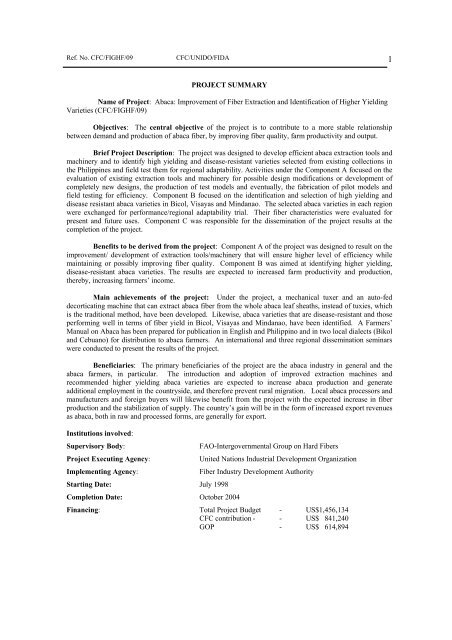ABACA Activities in the Philippines - Unido
ABACA Activities in the Philippines - Unido
ABACA Activities in the Philippines - Unido
Create successful ePaper yourself
Turn your PDF publications into a flip-book with our unique Google optimized e-Paper software.
Ref. No. CFC/FIGHF/09 CFC/UNIDO/FIDA 1<br />
PROJECT SUMMARY<br />
Name of Project: Abaca: Improvement of Fiber Extraction and Identification of Higher Yield<strong>in</strong>g<br />
Varieties (CFC/FIGHF/09)<br />
Objectives: The central objective of <strong>the</strong> project is to contribute to a more stable relationship<br />
between demand and production of abaca fiber, by improv<strong>in</strong>g fiber quality, farm productivity and output.<br />
Brief Project Description: The project was designed to develop efficient abaca extraction tools and<br />
mach<strong>in</strong>ery and to identify high yield<strong>in</strong>g and disease-resistant varieties selected from exist<strong>in</strong>g collections <strong>in</strong><br />
<strong>the</strong> Philipp<strong>in</strong>es and field test <strong>the</strong>m for regional adaptability. <strong>Activities</strong> under <strong>the</strong> Component A focused on <strong>the</strong><br />
evaluation of exist<strong>in</strong>g extraction tools and mach<strong>in</strong>ery for possible design modifications or development of<br />
completely new designs, <strong>the</strong> production of test models and eventually, <strong>the</strong> fabrication of pilot models and<br />
field test<strong>in</strong>g for efficiency. Component B focused on <strong>the</strong> identification and selection of high yield<strong>in</strong>g and<br />
disease resistant abaca varieties <strong>in</strong> Bicol, Visayas and M<strong>in</strong>danao. The selected abaca varieties <strong>in</strong> each region<br />
were exchanged for performance/regional adaptability trial. Their fiber characteristics were evaluated for<br />
present and future uses. Component C was responsible for <strong>the</strong> dissem<strong>in</strong>ation of <strong>the</strong> project results at <strong>the</strong><br />
completion of <strong>the</strong> project.<br />
Benefits to be derived from <strong>the</strong> project: Component A of <strong>the</strong> project was designed to result on <strong>the</strong><br />
improvement/ development of extraction tools/mach<strong>in</strong>ery that will ensure higher level of efficiency while<br />
ma<strong>in</strong>ta<strong>in</strong><strong>in</strong>g or possibly improv<strong>in</strong>g fiber quality. Component B was aimed at identify<strong>in</strong>g higher yield<strong>in</strong>g,<br />
disease-resistant abaca varieties. The results are expected to <strong>in</strong>creased farm productivity and production,<br />
<strong>the</strong>reby, <strong>in</strong>creas<strong>in</strong>g farmers’ <strong>in</strong>come.<br />
Ma<strong>in</strong> achievements of <strong>the</strong> project: Under <strong>the</strong> project, a mechanical tuxer and an auto-fed<br />
decorticat<strong>in</strong>g mach<strong>in</strong>e that can extract abaca fiber from <strong>the</strong> whole abaca leaf sheaths, <strong>in</strong>stead of tuxies, which<br />
is <strong>the</strong> traditional method, have been developed. Likewise, abaca varieties that are disease-resistant and those<br />
perform<strong>in</strong>g well <strong>in</strong> terms of fiber yield <strong>in</strong> Bicol, Visayas and M<strong>in</strong>danao, have been identified. A Farmers’<br />
Manual on Abaca has been prepared for publication <strong>in</strong> English and Philipp<strong>in</strong>o and <strong>in</strong> two local dialects (Bikol<br />
and Cebuano) for distribution to abaca farmers. An <strong>in</strong>ternational and three regional dissem<strong>in</strong>ation sem<strong>in</strong>ars<br />
were conducted to present <strong>the</strong> results of <strong>the</strong> project.<br />
Beneficiaries: The primary beneficiaries of <strong>the</strong> project are <strong>the</strong> abaca <strong>in</strong>dustry <strong>in</strong> general and <strong>the</strong><br />
abaca farmers, <strong>in</strong> particular. The <strong>in</strong>troduction and adoption of improved extraction mach<strong>in</strong>es and<br />
recommended higher yield<strong>in</strong>g abaca varieties are expected to <strong>in</strong>crease abaca production and generate<br />
additional employment <strong>in</strong> <strong>the</strong> countryside, and <strong>the</strong>refore prevent rural migration. Local abaca processors and<br />
manufacturers and foreign buyers will likewise benefit from <strong>the</strong> project with <strong>the</strong> expected <strong>in</strong>crease <strong>in</strong> fiber<br />
production and <strong>the</strong> stabilization of supply. The country’s ga<strong>in</strong> will be <strong>in</strong> <strong>the</strong> form of <strong>in</strong>creased export revenues<br />
as abaca, both <strong>in</strong> raw and processed forms, are generally for export.<br />
Institutions <strong>in</strong>volved:<br />
Supervisory Body:<br />
FAO-Intergovernmental Group on Hard Fibers<br />
Project Execut<strong>in</strong>g Agency:<br />
United Nations Industrial Development Organization<br />
Implement<strong>in</strong>g Agency:<br />
Fiber Industry Development Authority<br />
Start<strong>in</strong>g Date: July 1998<br />
Completion Date: October 2004<br />
F<strong>in</strong>anc<strong>in</strong>g: Total Project Budget - US$1,456,134<br />
CFC contribution - - US$ 841,240<br />
GOP - US$ 614,894

















